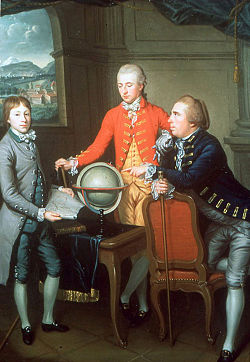| Grand Tour | |
 | |
| Itinerary type | Automotive |
|---|---|
The Grand Tour it was a long journey inEurope continental carried out by the rich young people of the European aristocracy starting from the seventeenth century and destined to perfect their knowledge with departure and arrival in the same city. It could last anywhere from a few months to several years, and usually had the destinationItaly.
Introduction
The term tourism and more generally, the phenomenon of today's tourist travel as a mass culture originated precisely from the “Grand Tour”.
How to get
Stages


Italy
Italy with its legacy of 1 Rome ancient, with its monuments, it became one of the most popular places to visit. In addition to the knowledge of the ancient world, the English thus came into contact with the works of Palladio and with Neoclassicism in 2 Naples. During the trip the young people could buy, according to their possibilities and means, numerous works of art and relics, and visit the ruins of Rome, but also of 3 Pompeii ed 4 Herculaneum, which had recently been rediscovered. Among the most important stops of the tour there was certainly the visit of Naples and gods 5 Campi Flegrei, which offered the possibility of visiting both archaeological sites and natural phenomena, such as volcanic activity. Goethe gives an example in his I travel to italy.
There was also a very important stage 6 Sicily, the volcanoes and the Greek and Baroque treasures of the island. At the same time, art students from all parts of Europe also came to Italy to learn from the ancient models. Sicily in fact offered the possibility of studying Greek art without having to face the journey in Greece, at the time Turkish domination, with the risks and prohibitions that its administration entailed. An important moment of the trip was the commission of a portrait to a well-known painter of the time, often during a prolonged stop in Rome, or even just the purchase of views of the Italian landscape.
During the 19th century, most of the educated young people took the "Grand Tour". Later this trip became fashionable for young women as well. A trip to Italy with the unmarried aunt as chaperone it was part of the education of the upper class lady. The practice of the Grand Tour became less frequent during the wars of the French Revolution and the Empire, but resumed with the Restoration, without however knowing the popularity of the previous century.
Other important Italian destinations were:
France
There France represented the pinnacle of style and sophistication, so young British people traveled to that country to get rid of their coarse behavior and adopt the manners that would make them stand out as the aristocracy of Great Britain. Under the watchful eye of the guardian and looked after by the valet, the young man set off. The first step in the tour was to cross The Sleeve for 15 Calais, in France. For many young people, the crossing was already a test to be faced, as the turbulent crossing often caused travelers to feel seasick. TO 16 Paris, all outward traces of British extraction were erased thanks to a new completely French wardrobe. Dressed like a Frenchman, he was now ready to be introduced into society. After experiencing the new life in the host capital, the grand-tourist went to 17 Dijon, 18 Lyon and finally 19 Marseille.
Switzerland
UK
Austria
Germany
Other destinations
Unusual destinations:
- 34 St.Pietroburgo
- 35 Madrid
- 36 Jerusalem
Safety
Around
Other projects
 Wikipedia contains an entry concerning Grand Tour
Wikipedia contains an entry concerning Grand Tour Commons contains images or other files on Grand Tour
Commons contains images or other files on Grand Tour Wikiquote contains quotes from or about Grand Tour
Wikiquote contains quotes from or about Grand Tour
